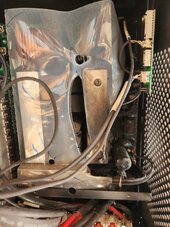Yesterday I had the MPPT board fail catastrophically in my Growatt SPF 12000T DVM-MPV.
I pulled into the driveway and opened the garage only to be met by a wall of smoke. I hit the DC and AC cutoffs outside and flipped the cut-off switch on each of my 3 batteries. I initially thought it was the batteries, but the acrid smell was more reminiscent of burnt resistor and circuit board. After confirming that each battery was in good shape, I turned to the inverter and saw soot on the lower right-hand side ventilation holes. I removed the front cover and, well...the pictures say it all.
The inverter has been up and running since early June 2022 with nothing major to be noted, just the "standard" quirks that the unit has.
I have 14x Mission Solar MSE320SR8T panels (Imp = 9.351A, Vmp = 34.22V) connected to the inverter in 2 arrays. (Array 1 = 5s2p, and Array 2 = 4s)
The last system stats recorded in SolarAssistant were as follows:
I pulled into the driveway and opened the garage only to be met by a wall of smoke. I hit the DC and AC cutoffs outside and flipped the cut-off switch on each of my 3 batteries. I initially thought it was the batteries, but the acrid smell was more reminiscent of burnt resistor and circuit board. After confirming that each battery was in good shape, I turned to the inverter and saw soot on the lower right-hand side ventilation holes. I removed the front cover and, well...the pictures say it all.
The inverter has been up and running since early June 2022 with nothing major to be noted, just the "standard" quirks that the unit has.
I have 14x Mission Solar MSE320SR8T panels (Imp = 9.351A, Vmp = 34.22V) connected to the inverter in 2 arrays. (Array 1 = 5s2p, and Array 2 = 4s)
The last system stats recorded in SolarAssistant were as follows:
- Power recorded coming from the panels totaled 755W
- 127v @ 3.61A for MPPT 1
- 56.2v @ 6A for MPPT 2
- Inverter temperature was 24.7C
- Battery voltage 52.7v (LiFePO4, 840AH)
Attachments
-
 1. When first opened.jpg213.3 KB · Views: 89
1. When first opened.jpg213.3 KB · Views: 89 -
 2. Close-up of the MPPT board.jpg191 KB · Views: 88
2. Close-up of the MPPT board.jpg191 KB · Views: 88 -
 3. Boards and fans.jpg281.6 KB · Views: 87
3. Boards and fans.jpg281.6 KB · Views: 87 -
 4. Rear of MPPT board.jpg196.8 KB · Views: 90
4. Rear of MPPT board.jpg196.8 KB · Views: 90 -
 5. Rear close-up of MPPT board.jpg155.9 KB · Views: 82
5. Rear close-up of MPPT board.jpg155.9 KB · Views: 82 -
 6. Front of controller board.jpg259.3 KB · Views: 73
6. Front of controller board.jpg259.3 KB · Views: 73 -
 7. Rear of controller board.jpg258.9 KB · Views: 66
7. Rear of controller board.jpg258.9 KB · Views: 66 -
 8. Board removed and basic wipedown done.jpg145.8 KB · Views: 87
8. Board removed and basic wipedown done.jpg145.8 KB · Views: 87





